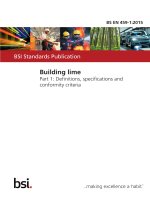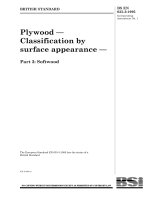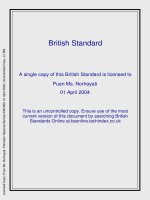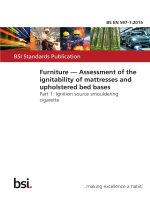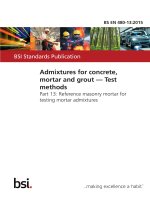Bsi bs en 61810 3 2015
Bạn đang xem bản rút gọn của tài liệu. Xem và tải ngay bản đầy đủ của tài liệu tại đây (1.18 MB, 18 trang )
BS EN 61810-3:2015
BSI Standards Publication
Electromechanical
elementary relays
Part 3: Relays with forcibly guided
(mechanically linked) contacts
BRITISH STANDARD
BS EN 61810-3:2015
National foreword
This British Standard is the UK implementation of EN 61810-3:2015. It is
identical to IEC 61810-3:2015. It supersedes BS EN 50205:2002 which is
withdrawn.
The UK participation in its preparation was entrusted to Technical
Committee EPL/94, General purpose relays and reed contact units.
A list of organizations represented on this committee can be obtained on
request to its secretary.
This publication does not purport to include all the necessary provisions of
a contract. Users are responsible for its correct application.
© The British Standards Institution 2015.
Published by BSI Standards Limited 2015
ISBN 978 0 580 84480 5
ICS 29.120.70
Compliance with a British Standard cannot confer immunity from
legal obligations.
This British Standard was published under the authority of the
Standards Policy and Strategy Committee on 31 May 2015.
Amendments/corrigenda issued since publication
Date
Text affected
BS EN 61810-3:2015
EUROPEAN STANDARD
EN 61810-3
NORME EUROPÉENNE
EUROPÄISCHE NORM
April 2015
ICS 29.120.70
Supersedes EN 50205:2002
English Version
Electromechanical elementary relays Part 3: Relays with forcibly guided (mechanically linked) contacts
(IEC 61810-3:2015)
Relais électromécaniques élémentaires Partie 3: Relais à contacts guidés (liés mécaniquement)
(IEC 61810-3:2015)
Elektromechanische Elementarrelais Teil 3: Relais mit (mechanisch) zwangsgeführten Kontakten
(IEC 61810-3:2015)
This European Standard was approved by CENELEC on 2015-04-01. CENELEC members are bound to comply with the CEN/CENELEC
Internal Regulations which stipulate the conditions for giving this European Standard the status of a national standard without any alteration.
Up-to-date lists and bibliographical references concerning such national standards may be obtained on application to the CEN-CENELEC
Management Centre or to any CENELEC member.
This European Standard exists in three official versions (English, French, German). A version in any other language made by translation
under the responsibility of a CENELEC member into its own language and notified to the CEN-CENELEC Management Centre has the
same status as the official versions.
CENELEC members are the national electrotechnical committees of Austria, Belgium, Bulgaria, Croatia, Cyprus, the Czech Republic,
Denmark, Estonia, Finland, Former Yugoslav Republic of Macedonia, France, Germany, Greece, Hungary, Iceland, Ireland, Italy, Latvia,
Lithuania, Luxembourg, Malta, the Netherlands, Norway, Poland, Portugal, Romania, Slovakia, Slovenia, Spain, Sweden, Switzerland,
Turkey and the United Kingdom.
European Committee for Electrotechnical Standardization
Comité Européen de Normalisation Electrotechnique
Europäisches Komitee für Elektrotechnische Normung
CEN-CENELEC Management Centre: Avenue Marnix 17, B-1000 Brussels
© 2015 CENELEC All rights of exploitation in any form and by any means reserved worldwide for CENELEC Members.
Ref. No. EN 61810-3:2015 E
BS EN 61810-3:2015
EN 61810-3:2015
-2-
Foreword
The text of document 94/378/FDIS, future edition 1 of IEC 61810-3, prepared by
IEC/TC 94 “All-ornothing electrical relays” was submitted to the IEC-CENELEC parallel vote and
approved by CENELEC as EN 61810-3:2015.
The following dates are fixed:
•
latest date by which the document has to be
implemented at national level by
publication of an identical national
standard or by endorsement
(dop)
2016-01-01
•
latest date by which the national
standards conflicting with the
document have to be withdrawn
(dow)
2018-04-01
This document supersedes EN 50205:2002.
Attention is drawn to the possibility that some of the elements of this document may be the subject of
patent rights. CENELEC [and/or CEN] shall not be held responsible for identifying any or all such
patent rights.
Endorsement notice
The text of the International Standard IEC 61810-3:2015 was approved by CENELEC as a European
Standard without any modification.
In the official version, for Bibliography, the following note has to be added for the standard indicated :
IEC 61810-2-1
NOTE
Harmonized as EN 61810-2-1.
BS EN 61810-3:2015
EN 61810-3:2015
-3-
Annex ZA
(normative)
Normative references to international publications
with their corresponding European publications
The following documents, in whole or in part, are normatively referenced in this document and are
indispensable for its application. For dated references, only the edition cited applies. For undated
references, the latest edition of the referenced document (including any amendments) applies.
NOTE 1 When an International Publication has been modified by common modifications, indicated by (mod), the relevant
EN/HD applies.
NOTE 2 Up-to-date information on the latest versions of the European Standards listed in this annex is available here:
www.cenelec.eu
Publication
Year
Title
EN/HD
IEC 60947-5-1
-
Low-voltage switchgear and controlgear - EN 60947-5-1
Part 5-1: Control circuit devices and
switching elements - Electromechanical
control circuit devices
-
IEC 61810-1
2015
Electromechanical elementary relays Part 1: General and safety requirements
2015
IEC 61810-7
-
Electromechanical elementary relays EN 61810-7
Part 7: Test and measurement procedures
EN 61810-1
Year
-
–2–
BS EN 61810-3:2015
IEC 61810-3:2015 © IEC 2015
CONTENTS
FOREWORD ........................................................................................................................... 3
INTRODUCTION ..................................................................................................................... 5
1
Scope .............................................................................................................................. 6
2
Normative references ....................................................................................................... 6
3
Terms and definitions....................................................................................................... 6
4
Functional requirements ................................................................................................... 7
4.1
Forcibly guided (mechanically linked) operation ....................................................... 7
4.2
Changeover contacts ............................................................................................... 7
4.3
Mechanical endurance............................................................................................. 8
4.4
Electrical endurance ................................................................................................ 8
4.5
Operating conditions ............................................................................................... 8
4.5.1
Ambient temperature ........................................................................................ 8
4.5.2
Energizing quantity........................................................................................... 8
4.6
Characteristic values and marking ........................................................................... 8
4.6.1
Characteristic values ........................................................................................ 8
4.6.2
Marking ........................................................................................................... 8
5
Verification and type tests ................................................................................................ 9
5.1
Design verification ................................................................................................... 9
5.2
Type tests ............................................................................................................... 9
5.3
Test procedure ...................................................................................................... 10
5.3.1
Testing for failure to open .............................................................................. 10
5.3.2
Mechanical and electrical endurance .............................................................. 10
Bibliography .......................................................................................................................... 11
Figure 1 – Symbol for a forcibly guided (mechanically linked) contact set, type A ..................... 8
Figure 2 – Symbols for use on type B relays ............................................................................ 9
BS EN 61810-3:2015
IEC 61810-3:2015 © IEC 2015
–3–
INTERNATIONAL ELECTROTECHNICAL COMMISSION
____________
ELECTROMECHANICAL ELEMENTARY RELAYS –
Part 3: Relays with forcibly guided (mechanically linked) contacts
FOREWORD
1) The International Electrotechnical Commission (IEC) is a worldwide organization for standardization comprising
all national electrotechnical committees (IEC National Committees). The object of IEC is to promote
international co-operation on all questions concerning standardization in the electrical and electronic fields. To
this end and in addition to other activities, IEC publishes International Standards, Technical Specifications,
Technical Reports, Publicly Available Specifications (PAS) and Guides (hereafter referred to as “IEC
Publication(s)”). Their preparation is entrusted to technical committees; any IEC National Committee interested
in the subject dealt with may participate in this preparatory work. International, governmental and nongovernmental organizations liaising with the IEC also participate in this preparation. IEC collaborates closely
with the International Organization for Standardization (ISO) in accordance with conditions determined by
agreement between the two organizations.
2) The formal decisions or agreements of IEC on technical matters express, as nearly as possible, an international
consensus of opinion on the relevant subjects since each technical committee has representation from all
interested IEC National Committees.
3) IEC Publications have the form of recommendations for international use and are accepted by IEC National
Committees in that sense. While all reasonable efforts are made to ensure that the technical content of IEC
Publications is accurate, IEC cannot be held responsible for the way in which they are used or for any
misinterpretation by any end user.
4) In order to promote international uniformity, IEC National Committees undertake to apply IEC Publications
transparently to the maximum extent possible in their national and regional publications. Any divergence
between any IEC Publication and the corresponding national or regional publication shall be clearly indicated in
the latter.
5) IEC itself does not provide any attestation of conformity. Independent certification bodies provide conformity
assessment services and, in some areas, access to IEC marks of conformity. IEC is not responsible for any
services carried out by independent certification bodies.
6) All users should ensure that they have the latest edition of this publication.
7) No liability shall attach to IEC or its directors, employees, servants or agents including individual experts and
members of its technical committees and IEC National Committees for any personal injury, property damage or
other damage of any nature whatsoever, whether direct or indirect, or for costs (including legal fees) and
expenses arising out of the publication, use of, or reliance upon, this IEC Publication or any other IEC
Publications.
8) Attention is drawn to the Normative references cited in this publication. Use of the referenced publications is
indispensable for the correct application of this publication.
9) Attention is drawn to the possibility that some of the elements of this IEC Publication may be the subject of
patent rights. IEC shall not be held responsible for identifying any or all such patent rights.
International Standard IEC 61810-3 has been prepared by IEC technical committee 94: All-ornothing electrical relays.
The content of this standard was already published in EN 50205:2002. The revisions in this
standard only involve editorial changes and update of references.
The text of this standard is based on the following documents:
FDIS
Report on voting
94/378/FDIS
94/382/RVD
Full information on the voting for the approval of this standard can be found in the report on
voting indicated in the above table.
–4–
BS EN 61810-3:2015
IEC 61810-3:2015 © IEC 2015
This publication has been drafted in accordance with the ISO/IEC Directives, Part 2.
A list of all parts of IEC 61810 series, published under the general title Electromechanical
elementary relays can be found on the IEC website.
The committee has decided that the contents of this publication will remain unchanged until the
stability date indicated on the IEC website under "" in the data related to
the specific publication. At this date, the publication will be
•
•
•
•
reconfirmed,
withdrawn,
replaced by a revised edition, or
amended.
BS EN 61810-3:2015
IEC 61810-3:2015 © IEC 2015
–5–
INTRODUCTION
This Standard applies to elementary relays in which special design and constructional
measures are used to ensure that make (normally-open) contacts cannot assume the same
state as break (normally-closed) contacts. These relays can be used in self-monitoring control
systems, e.g. safety-related control systems.
–6–
BS EN 61810-3:2015
IEC 61810-3:2015 © IEC 2015
ELECTROMECHANICAL ELEMENTARY RELAYS –
Part 3: Relays with forcibly guided (mechanically linked) contacts
1
Scope
This part of IEC 61810 specifies special requirements and tests for elementary relays with
forcibly guided contacts, also known as mechanically linked contacts. These special
requirements apply in addition to the general requirements of IEC 61810-1.
NOTE 1
This standard does not apply to electromechanical control circuit devices as described in IEC 60947-5-1.
NOTE 2
IEC 61810-2-1 provides guidelines for the assignment of reliability values.
NOTE 3
Contacts that are not mechanically linked (forcibly guided) are not considered in this standard.
2
Normative references
The following documents, in whole or in part, are normatively referenced in this document and
are indispensable for its application. For dated references, only the edition cited applies. For
undated references, the latest edition of the referenced document (including any amendments)
applies.
IEC 60947-5-1, Low-voltage switchgear and controlgear – Part 5-1: Control circuit devices and
switching elements – Electromechanical control circuit devices
IEC 61810-1:2015, Electromechanical elementary relays – Part 1: General and safety
requirements
IEC 61810-7, Electromechanical elementary relays – Part 7: Test and measurement
procedures
3
Terms and definitions
For the purposes of this document, the following terms and definitions apply.
3.1
elementary relay
non-specified time all-or-nothing relay
Note 1 to entry:
In this document the word “elementary” is sometimes omitted for clarity.
[SOURCE: IEC 60050-444:2002, 444-01-03, modified – modification of the definition]
3.2
failure to open
fault condition when a contact does not open when expected to do so
3.3
failure criteria
specified conditions to judge if a fault or malfunction is a failure
BS EN 61810-3:2015
IEC 61810-3:2015 © IEC 2015
–7–
3.4
fault
fault condition
deviation of the existing condition from the expected condition
3.5
failure
termination of the ability of an item to perform a required function as defined in the failure
criteria
3.6
relay with mechanically linked contacts
relay with forcibly guided contacts
elementary relay with at least one make contact and at least one break contact and including
mechanical measures to prevent any make contact(s) and any break contact(s) being in the
closed position simultaneously
3.7
type A
relay in which all contacts are mechanically linked
3.8
type B
relay containing contacts that are mechanically linked to each other as well as contacts that are
not mechanically linked
4
4.1
Functional requirements
Forcibly guided (mechanically linked) operation
The relay shall be designed such that if a make contact is closed, none of the mechanically
linked break contacts can close and that if a break contact is closed, none of the mechanically
linked make contacts can close. These requirements apply throughout the lifetime of the relay
and under reasonably foreseeable failure conditions.
The effects of reasonably foreseeable breakage of and/or wear to parts of the elementary relay
shall not nullify the function of forcibly guided (mechanically linked) operation.
Contact gaps of open contacts shall be greater than 0,5 mm for single break contacts and
0,3 mm each for double break contacts throughout the manufacturer’s specified endurance of
the relay.
Operation of forcibly guided (mechanically linked) contacts means that if any make contact fails
to open when the relay is de-energized, none of the break contacts shall close. If any break
contact fails to open when the relay is energized, no make contact shall close.
4.2
Changeover contacts
Only break contacts and make contacts are covered by this standard; in the case of relays that
include changeover contacts, either the make circuit or the break circuit of a changeover
contact can be considered to meet the requirements of this standard.
Changeover contacts shall be break-before-make. It shall be assured that the forcibly guided
operation is maintained, as described under the fault conditions described in 5.1.
NOTE Special care is taken in the design of the application to ensure that the integrity of the safety-related circuit
is maintained in the event of a failure.
–8–
4.3
BS EN 61810-3:2015
IEC 61810-3:2015 © IEC 2015
Mechanical endurance
Elementary relays containing forcibly guided (mechanically linked) contacts shall have a
7
mechanical endurance of at least 10 operating cycles.
4.4
Electrical endurance
The electrical endurance shall be as specified by the manufacturer in accordance with
IEC 61810-1.
4.5
Operating conditions
4.5.1
Ambient temperature
Elementary relays with forcibly guided (mechanically linked) contacts shall function correctly
over an ambient temperature range of at least –10 °C to +55 °C.
4.5.2
Energizing quantity
Unless otherwise stated by the manufacturer, elementary relays with forcibly guided
(mechanically linked) contacts shall at least correspond to class ‘2’ in the operative range of
their rated coil voltage (see 5.3.1 of IEC 61810-1:2015).
4.6
Characteristic values and marking
4.6.1
Characteristic values
The manufacturer shall state in his documentation the following:
a) whether the relay is type A or type B. In the case of type B relays, which contacts are
mechanically linked and which contacts are not mechanically linked;
b) the vibration resistance over the frequency range at least from f = 10 Hz to 200 Hz (see
IEC 61810-7);
c) the shock resistance of the relay in accordance with IEC 61810-7;
d) the contact load(s) according to IEC 61810-1:2015, Annex B or the utilization category(ies)
in accordance with IEC 60947-5-1;
NOTE
Commonly utilisation categories AC15 and DC13 are applied.
e) the limits of the operative range.
4.6.2
Marking
Relays with forcibly guided (mechanically linked) contacts shall be marked to indicate whether
they are type A or type B. If a contact schematic is marked on the relay then the following
marking shall be placed adjacent to the schematic.
Type A relays with forcibly guided (mechanically linked) contacts shall be marked either with
the words “type A” or with the symbol given in the Figure 1 below:
Figure 1 – Symbol for a forcibly guided (mechanically linked) contact set, type A
BS EN 61810-3:2015
IEC 61810-3:2015 © IEC 2015
–9–
Type B relays with forcibly guided (mechanically linked) contacts shall be marked either with
the words “type B” or with the symbols given in the Figure 2 (Source ISO 7000:2014/Figure
0434) below:
or
Figure 2 – Symbols for use on type B relays
5
Verification and type tests
5.1
Design verification
A failure mode and effect analysis shall be performed considering all parts that are involved in
the forcibly guided (mechanically linked) operation. The analysis shall consider the breakage
and wear of these parts as well as failure to open.
All reasonably foreseeable single faults shall be assumed and their effects considered. If the
fault of a part leads directly to a second fault then the two faults shall be considered. If the fault
of a part is excluded as a failure criteria, the manufacturer shall justify the exclusion, for
example by design calculations or measurements showing over-dimensioning. The failure
criteria “spring broken” shall not be excluded.
It shall be considered whether, in case any electrically conductive parts break or come loose,
the construction of the elementary relay prevents any short-circuits or conductive connections
from occurring which would nullify the function of forcibly guided (mechanically linked)
operation.
NOTE 1 Bridging by conductive parts can be prevented by such means as, for example, insulation or other
appropriate methods applied between the conducting parts.
NOTE 2
Examples of conductive parts are contacts, contact springs and return springs.
The failure of movable functional parts as a result of, for example, breakage or wear shall be
considered and the result expected shall be evaluated.
NOTE 3
5.2
An example of a movable functional part is the actuator of the contact set.
Type tests
Type tests shall be performed to verify the function of forcibly guided (mechanically linked)
operation.
The tests shall be performed on new relays and also on relays that have been subjected to the
electrical and mechanical endurance tests.
The test shall be conducted by simulating the welding of a contact of the elementary relay. The
simulated welding shall be performed under worst case conditions using a separate sample for
each make contact and each break contact. A separate sample shall be used for each
simulated contact welding unless it can be demonstrated by analysis that a reduced number of
samples will give an equivalent test result.
Welding of the contacts shall be simulated by such means as, for example, soldering the
contacts together or using an appropriate glue. The thickness of the contact tips shall not
change by more than 0,02 mm as a result of having been soldered or glued. Break contacts
– 10 –
BS EN 61810-3:2015
IEC 61810-3:2015 © IEC 2015
shall be soldered or glued with the relay in the release condition. Make contacts shall be
soldered or glued with the relay energised at the lower limit of the operative range.
The defect shall be built into break contacts with the elementary relay in the release condition.
The defect shall be built into make contacts at the lower limit of the operative range of the coil
voltage.
5.3
Test procedure
5.3.1
5.3.1.1
Testing for failure to open
Verification of the contact gap
The tests shall be performed at an ambient temperature of (23 ± 5) °C.
Either of the following methods may be used to verify the contact gap. The manufacturer shall
state in his documentation which method is used:
a) an optical check to determine if the contact gap is ≥ 0,5 mm in the case of single break
contacts, ≥ 0,3 mm in the case of double break contacts;
b) it shall be possible to pass a measurement wire with a diameter of 0,5 +−00,,02
0 mm in the case
of single break contacts, 0,3 +−00,,02
0 mm in the case of double break contacts between the
contact tips without the wire closing the circuit that includes the contact(s).
It shall be verified by analysis and/or additional tests as necessary that these requirements are
met throughout the manufacturer’s specified operating temperature range.
5.3.1.2
5.3.1.2.1
Testing
Failure to open of a make contact
After a defect has been built into a make contact and the relay de-energized, it shall be verified
that the contact gap of any break contact is ≥ 0,5 mm / ≥ 0,3 mm.
The relay shall then be energized with the maximum coil voltage for ≥ 5 min then de-energized
and the contact gap verified immediately.
5.3.1.2.2
Failure to open of a break contact
After a defect has been built into a break contact and the relay energized with the maximum
coil voltage the contact gap of any make contact shall be ≥ 0,5 mm / ≥ 0,3 mm.
The contact gap shall be verified
a) immediately after the application of the coil voltage,
b) after the relay has been energized for ≥ 5 min.
The tests shall be performed at an ambient temperature of (23 ± 5) °C. For the test,
consideration shall be given to the effect of the permissible range of operating temperature by
recalculating the values of the energizing quantity.
The contact gap of the make contact shall be determined after energizing the elementary relay
with the maximum value of the energizing quantity.
5.3.2
Mechanical and electrical endurance
The effects of wear shall be determined by means of appropriate endurance tests as specified
in 4.3 and 4.4.
BS EN 61810-3:2015
IEC 61810-3:2015 © IEC 2015
– 11 –
Bibliography
IEC 60050-444:2002, International Electrotechnical Vocabulary – Part 444: Elementary relays
IEC 61810-2-1, Electromechanical elementary relays – Part 2-1: Reliability – Procedure for the
verification of B 10 values
ISO 7000:2014, Graphical symbols for use on equipment – Registered symbols
_____________
This page deliberately left blank
This page deliberately left blank
NO COPYING WITHOUT BSI PERMISSION EXCEPT AS PERMITTED BY COPYRIGHT LAW
British Standards Institution (BSI)
BSI is the national body responsible for preparing British Standards and other
standards-related publications, information and services.
BSI is incorporated by Royal Charter. British Standards and other standardization
products are published by BSI Standards Limited.
About us
Revisions
We bring together business, industry, government, consumers, innovators
and others to shape their combined experience and expertise into standards
-based solutions.
Our British Standards and other publications are updated by amendment or revision.
The knowledge embodied in our standards has been carefully assembled in
a dependable format and refined through our open consultation process.
Organizations of all sizes and across all sectors choose standards to help
them achieve their goals.
Information on standards
We can provide you with the knowledge that your organization needs
to succeed. Find out more about British Standards by visiting our website at
bsigroup.com/standards or contacting our Customer Services team or
Knowledge Centre.
Buying standards
You can buy and download PDF versions of BSI publications, including British
and adopted European and international standards, through our website at
bsigroup.com/shop, where hard copies can also be purchased.
If you need international and foreign standards from other Standards Development
Organizations, hard copies can be ordered from our Customer Services team.
Subscriptions
Our range of subscription services are designed to make using standards
easier for you. For further information on our subscription products go to
bsigroup.com/subscriptions.
With British Standards Online (BSOL) you’ll have instant access to over 55,000
British and adopted European and international standards from your desktop.
It’s available 24/7 and is refreshed daily so you’ll always be up to date.
You can keep in touch with standards developments and receive substantial
discounts on the purchase price of standards, both in single copy and subscription
format, by becoming a BSI Subscribing Member.
PLUS is an updating service exclusive to BSI Subscribing Members. You will
automatically receive the latest hard copy of your standards when they’re
revised or replaced.
To find out more about becoming a BSI Subscribing Member and the benefits
of membership, please visit bsigroup.com/shop.
With a Multi-User Network Licence (MUNL) you are able to host standards
publications on your intranet. Licences can cover as few or as many users as you
wish. With updates supplied as soon as they’re available, you can be sure your
documentation is current. For further information, email
BSI Group Headquarters
389 Chiswick High Road London W4 4AL UK
We continually improve the quality of our products and services to benefit your
business. If you find an inaccuracy or ambiguity within a British Standard or other
BSI publication please inform the Knowledge Centre.
Copyright
All the data, software and documentation set out in all British Standards and
other BSI publications are the property of and copyrighted by BSI, or some person
or entity that owns copyright in the information used (such as the international
standardization bodies) and has formally licensed such information to BSI for
commercial publication and use. Except as permitted under the Copyright, Designs
and Patents Act 1988 no extract may be reproduced, stored in a retrieval system
or transmitted in any form or by any means – electronic, photocopying, recording
or otherwise – without prior written permission from BSI. Details and advice can
be obtained from the Copyright & Licensing Department.
Useful Contacts:
Customer Services
Tel: +44 845 086 9001
Email (orders):
Email (enquiries):
Subscriptions
Tel: +44 845 086 9001
Email:
Knowledge Centre
Tel: +44 20 8996 7004
Email:
Copyright & Licensing
Tel: +44 20 8996 7070
Email:

